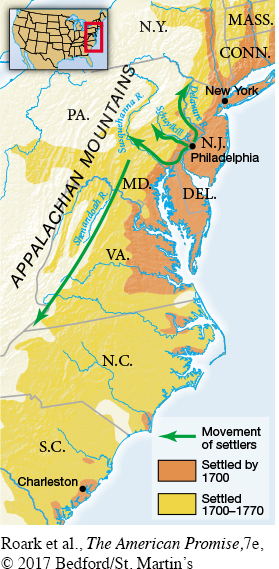The American Promise: Printed Page 115
The American Promise, Value Edition: Printed Page 106
The American Promise: A Concise History: Printed Page 121
“God Gives All Things to Industry”: Urban and Rural Labor
The American Promise: Printed Page 115
The American Promise, Value Edition: Printed Page 106
The American Promise: A Concise History: Printed Page 121
Page 115An indentured servant in 1743 wrote that Pennsylvania was “the best poor Man’s Country in the World.” Although the servant reported that “the Condition of bought Servants is very hard” and masters often failed to live up to their promise to provide decent food and clothing, opportunity abounded in the middle colonies because there was more work to be done than workers to do it.
Most servants toiled in Philadelphia, New York City, or one of the smaller towns or villages. Artisans, small manufacturers, and shopkeepers prized the labor of male servants. Female servants made valuable additions to households, where nearly all of them cleaned, washed, cooked, or minded children. From the masters’ viewpoint, servants were a bargain. A master could purchase five or six years of a servant’s labor for approximately the wages a common laborer would earn in four months.
Since a slave cost about three times more than a servant, only affluent colonists could afford the long-
Most slaves came to the middle colonies and New England after a stopover in the West Indies, as the Robin Johns did. Very few came directly from Africa. Slaves—
Whites’ racism and blacks’ lowly social status made African Americans scapegoats for European Americans’ suspicions and anxieties. In 1741, when arson and several unexplained thefts plagued New York City, officials suspected a murderous slave conspiracy and executed thirty-
Immigrants swarmed to the middle colonies because of the availability of land. The Penn family (see “New Jersey and Pennsylvania” in chapter 4) encouraged immigration to bring in potential buyers for their enormous tracts of land in Pennsylvania. From the beginning, Pennsylvania followed a policy of negotiating with Indian tribes to purchase additional land. This policy reduced the violent frontier clashes more common elsewhere in the colonies. Few colonists drifted beyond the northern boundaries of Pennsylvania. Owners of the huge estates in New York’s Hudson valley preferred to rent rather than sell their land, and therefore they attracted fewer immigrants. The Iroquois Indians dominated the lucrative fur trade of the St. Lawrence valley and eastern Great Lakes, and they vigorously defended their territory from colonial encroachment, causing most settlers to prefer the comparatively safe environs of Pennsylvania.
Since the cheapest land always lay at the margin of settlement, would-

The American Promise: Printed Page 115
The American Promise, Value Edition: Printed Page 106
The American Promise: A Concise History: Printed Page 121
Page 116Farmers like the Lincolns made the middle colonies the breadbasket of North America. They planted a wide variety of crops to feed their families, but they grew wheat in abundance. Flour milling was the number one industry and flour the number one export, constituting nearly three-
Philadelphia stood at the crossroads of trade in wheat exports and British imports. Merchants occupied the top stratum of Philadelphia society. In a city where only 2 percent of the residents owned enough property to qualify to vote, merchants built grand homes and dominated local government. Many of Philadelphia’s wealthiest merchants were Quakers. Quaker traits of industry, thrift, honesty, and sobriety encouraged the accumulation of wealth. A colonist complained that a Quaker “prays for his neighbors on First Days [Sabbaths] and then preys on him the other six.”
The American Promise: Printed Page 115
The American Promise, Value Edition: Printed Page 106
The American Promise: A Concise History: Printed Page 121
Page 117The lower ranks of merchants included aspiring tradesmen such as Benjamin Franklin. In 1728, Franklin opened a small shop, run mostly by his wife, Deborah, that sold a little of everything: cheese, codfish, coffee, goose feathers, soap, and occasionally a slave. In 1733, Franklin began to publish Poor Richard’s Almanack, which preached the likelihood of long-
Although Quakers remained influential in Pennsylvania, Franklin spoke for most colonists with his aphorisms of work, discipline, and thrift that celebrated the spark of ambition and the promise of worldly gain.
REVIEW Why did immigrants flood into Pennsylvania during the eighteenth century?